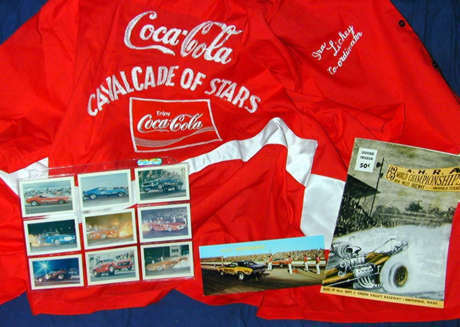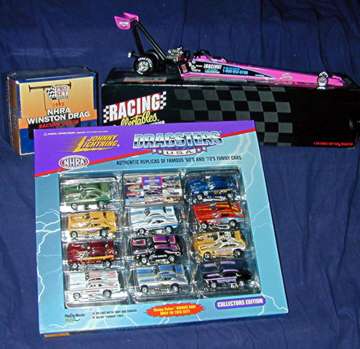|
|
 |
||||
 |
|||||
|
Will The Real Memorabilia Please Stand Up!
The decade of the 1990’s saw the first true advent of the racing collectibles market. Particularly in NASCAR racing but in many other types of racing as well, companies like Action, Racing Champions, and others made millions of dollars selling diecast replicas of specific race cars and special edition items featuring favorite racers. For many racing collectors, these items offered new opportunities to own and amass material about their favorite motorsport or driver. However, they have also created something of a price hysteria, and this led to a lot of questioning about their true value. In the first installment of this column, we talked about high dollar handouts. Handouts are unique in that they were never manufactured for resale; they were produced instead as free promotional material (though some drivers did originally sell them for a nominal fee). To obtain them, a person needed to get them right from the driver or sponsor. There was no mail order or shelf stock availability. Therefore, current values have been perceived or understood based on rarity, quality and overall desirability; they had no value beyond the promotional at the time they were created. On the other hand, the diecast cars and trading cards of the collectibles age have been produced solely as “manufactured memorabilia.” Values are established based on a set retail price, and some people who have bought them have done so as an investment. The big question that has to be asked is whether they are going to go up in price or even hold their retail cost.
In the last decade, the diecast market and special insert trading cards have sometimes seen severe price spikes (i.e. an item with a retail price of $69.95 hitting $200) soon after their release as active trading made them hard to come by. Since there were x-number produced, the perceived rarity was built in. However, these same items quickly settled down to more realistic levels as new items were released and the demand was met. There are a few exceptions to this rule, like some of the John Force and Blaine Johnson items, but overall this has been true. What’s more, disgruntled collectors, mail order sellers with small margins, and dealers with overstock can throw this market into mild chaos when they attempt to get rid of their excess stock, eroding the perceived value even more by selling below retail or even wholesale costs. Trading cards inserts have proven to last about 24 months at a higher value and then that becomes a buyers market as well, “buyers” who may be hard to come by as they chase the “new” thing. As a result, this sometimes becomes a market place subject to the whims of a dynamic manufacturing sector, not actual forces of supply and demand. There is also a novelty factor that needs to be considered. “Wow, it’s a new thing, I’ve got have it!” helps drive this market, but in hindsight may leave the purchaser unsatisfied with the item, meaning this purchase too may hit the market soon after, but at a much lower asking price. Does this mean that this stuff is worthless? No, not at all. Much of the current generation collectibles are manufactured with a high degree of quality in mind, and items of a similar nature (i.e. military replicas or model railroad items) are priced in the same ranges. However, it would be wise to be careful how much you decide to spend on any one of these items or the overall value of your collection. Nobody wants to see a $75 “investment” be worth only $25 when it comes time to sell it. This is true of all memorabilia and collectibles, so it sometimes pays to spend smart and be patient. If you still have to have that flamed Force Olds, you will probably have to pay real money for it now, but that is an exception to the rule. Buy what you like, and not just to “have it all,” and be willing to wait if you think the price is too high. With any larger accumulation, it should also be noted that the number of potential buyers will be lower as the collection increases in size; liquidating it may be more difficult than you think. One dealer wisely said that true value can be perceived by whether the seller will buy it back from you, even if that means at a lesser margin then retail; can you sell this stuff back to the person or people who you purchased it from in the first place, or are they not interested? Food for thought! GENERAL RELEASE ITEMS Obviously, in the case of older material not amassed in the age of “collectibles,” condition plays a vital role in pricing, which brings up a final problem with the manufactured sector. If the collectibles boxes are damaged, or the item perchance fades due to exposure to direct sunlight, the value will almost certainly plummet since a vast majority of the surviving examples will still be perfect. In the realm of vintage material, even damaged items will hold a relative value since it is not known how many exist and the buyer does not know if another opportunity to purchase a better example will occur. I try to stick to a rule to buy what I like and not worry about completing a series or set unless there is an obvious reason to do so, such as numbered trading cards. If you like diecast stuff, then you should go and buy the pieces you like. However, true investments should be made where there are some real opportunities to see increase. Collections are certainly investments, but foremost need to be created out of an intrinsic love or desire to own the collected. Buying simply to see an increase is best left to the stock brokers! Buying and selling drag racing’s history. Contact Geoff Stunkard at stunkard@preferred.com . Selling on ebay under the same name.
|
|||||
 |
|||||
|
Copyright 1999-2001, Drag Racing Online and Racing Net Source |
|||||

